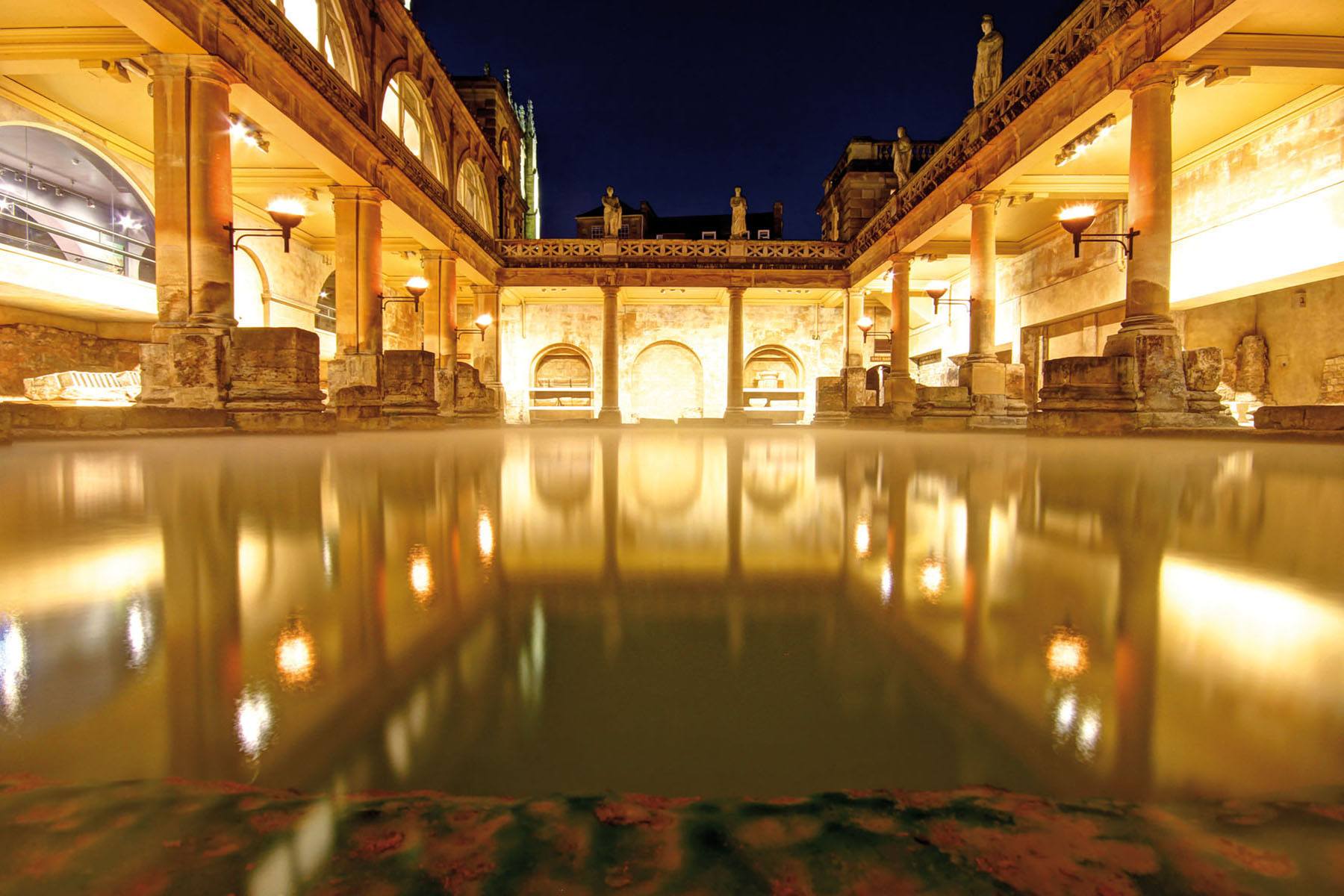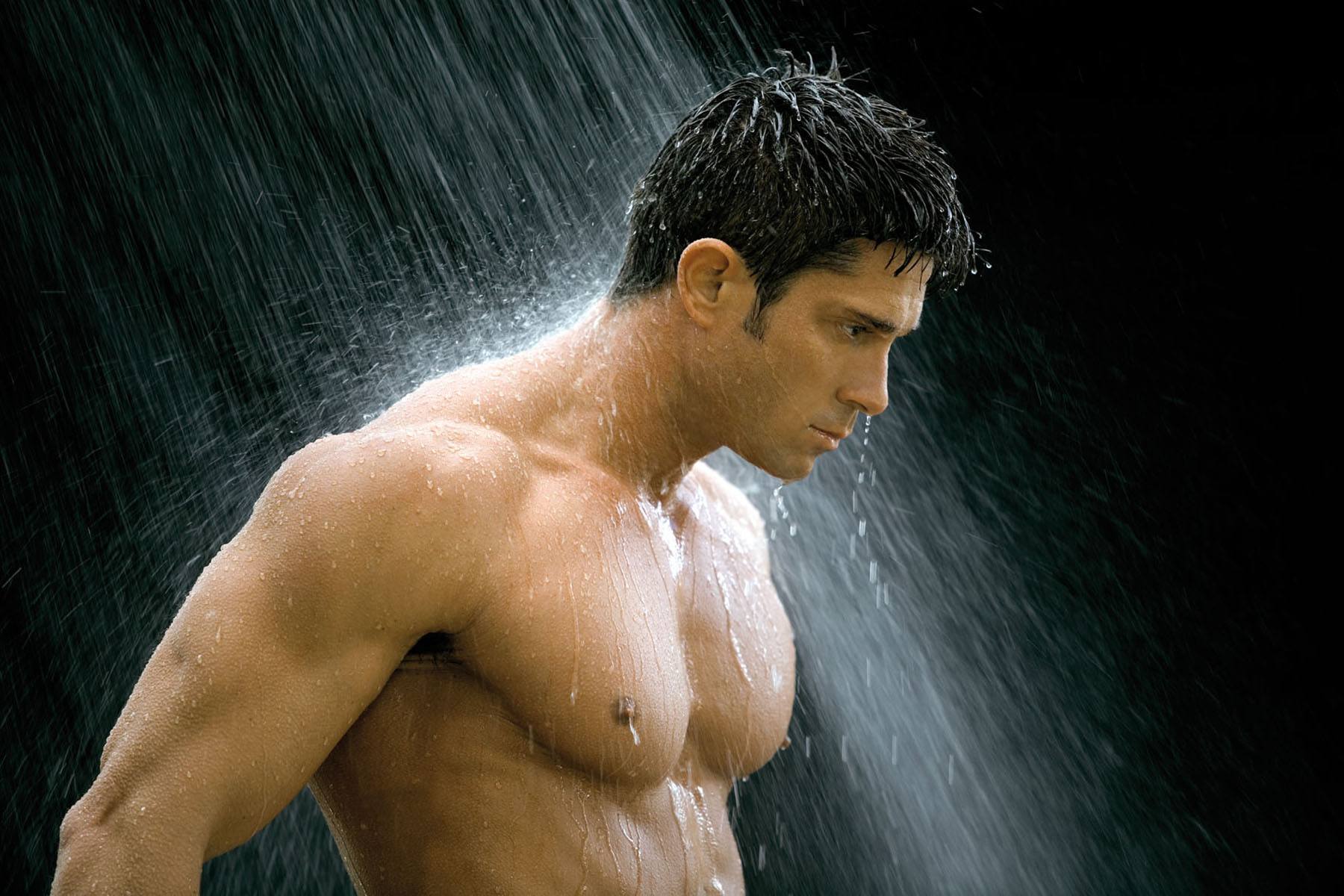Die kalte Jahreszeit ist für die meisten von uns eine echte Herausforderung, was die Hautpflege betrifft. Die trockene Luft in der Kälte und die Windeinschläge im Winter erhöhen das Risiko für trockene Haut und Ekzeme. Aber das heißt nicht, dass wir uns der Situation ergeben müssen! Mit den folgenden 4 Tipps können Sie Ihre Haut im Winter schützen:
1. Hydratation: Unsere Haut ist viel mehr als eine Barriere gegen äußere Einflüsse. Sie hält uns warm und speichert Feuchtigkeit. Wenn es draußen kalt und trocken ist, sollte man seine Haut regelmäßig mit einer reichhaltigen Feuchtigkeitscreme oder einem Serum einmassieren. So bekommt man die benötigte Feuchtigkeit zurück, sodass sie glatt und geschmeidig bleibt.
2. Reinigung: Die Verwendung eines milden Reinigers ist unerlässlich, da es hilft, überschüssige Öle und Ablagerungen von der Oberfläche der Haut zu entfernen. Ein guter Reiniger hat auch die Fähigkeit, die Poren sanft zu reinigen, ohne sie austrocknen zu lassen.
3. Exfoliation: Regelmäßige Peelings helfen unserer Haut dabei, tote Zellen loszuwerden und neue Zellen hervorzubringen. Dieser Prozess erhöht die Durchblutung und stimuliert die Produktion von Kollagen in den tieferen Schichten der Haut – was wiederum hilft, Falten zu reduzieren und dem Teint mehr Glanz zu verleihen. Die trockene Luft im Winter macht unserer Haut sehr zu schaffen, daher ist es wichtig, täglich eine Feuchtigkeitscreme aufzutragen. Achten Sie darauf, die Creme nicht zu dick aufzutragen, da sonst unangenehme Pickel entstehen können.
4. Schutz: Da es sich bei Sonnenstrahlen um UVA-Strahlen handelt, müssen wir unserer Haut auch im Winter schützende Maßnahmen angedeihen lassen! Achten Sie also darauf, dass Ihre Feuchtigkeitscreme SPF enthält (mindestens 15). So sorgen Sie dafür, dass Ihre Haut vor schädlichen UV-Strahlen geschützt ist – auch an grauen Tagen!
Mit dieser Strategie können Sie Ihre Haut nachweislich vor den widrigsten Bedingungen des Winters schützen. Folgen Sie also diesem Rat und genießen Sie eine gesunde und strahlende Haut im Winter!
In search of extraordinary methods of shaving, the idea of travelling to India was born. As his tasker, ESBjERG gave Hannes Seebacher the time and effort he needed. Without further plans but a whole lot of creativity and sensitivity, Hannes Seebacher started his journey into the unkown. His only travel companion was a small black journal in which he wrote down his observations and impressions. Reading through the pages the adventure can be brought back to life. Such a travel companion is for one loyal and also patient, sharing all its well-kept stories and reviving forgotten memories. Eager for his trip to start, his first entry was already written on the plane.
Arriving in New-Dehli, Hannes Seebacher got to know the city in all its shapes and sizes. The inhabitants made a relaxed and calm impression on him. After experiencing the metropolis, it was time to discover nature’s beauty. What could possibly be more exciting than to scout through the barrenness of the desert?
Hannes Seebacher held on to his idea of traveling through the desert land. Confident of his idea, he organized himself a guide to accompany him on his journey, a man named Marthar. Walking through heat and sand, the two men became close friends. Trekking through the desert’s shrubs and sand, guided by only three camels and Mathar, this part of the journey was especially memorable to Hannes Seebacher, feeling like discovering the moonscape. For the nature fascinated artist, the walk through the desert was a real sensation, serving as inspiration for many of his later works and ideas. Such as buying a camel for his friend Mathar, so he could work as a guide independently. Only having two camels left, one was kept by himself and the other one was acquired by ESBjERG. To help his friend Mathar into self-employment, he offered further help and support even when already being back in Europe.
Nature’s beauty even inspired him to devote the only tree they passed in the desert to ESBjERG. He simply cut into the tree’s bark, in order for it to hold his shaving utensils and to hang up his little travel mirror. Sitting on blanket, in the middle of the barren landscape, he used the opportunity to shave. This is the story to the wonderful picture bellow.
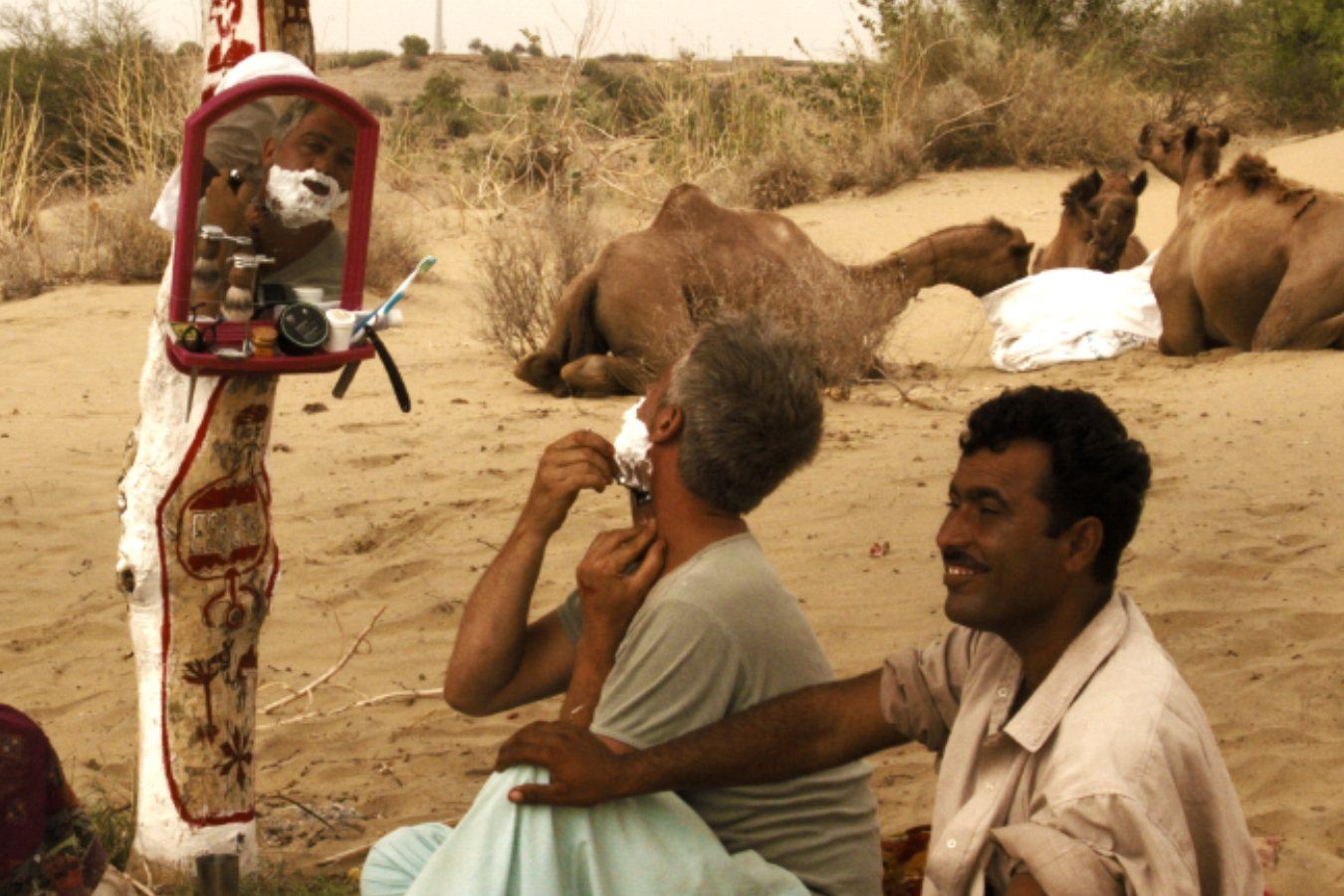
Another destination on his trip was Jaisalmer- the village in the heart of the desert. The houses surrounding the small town are made of yellow and brown sandstone, which look as if they are melting into the same colored ground. Inside the barber shop of the village, a perfect picture was taken. Here you can see Hannes Seebacher shaving his dear friend Mathar. Passengers stopped and enjoyed the unusual sight, adding much joy to this amusing incident.
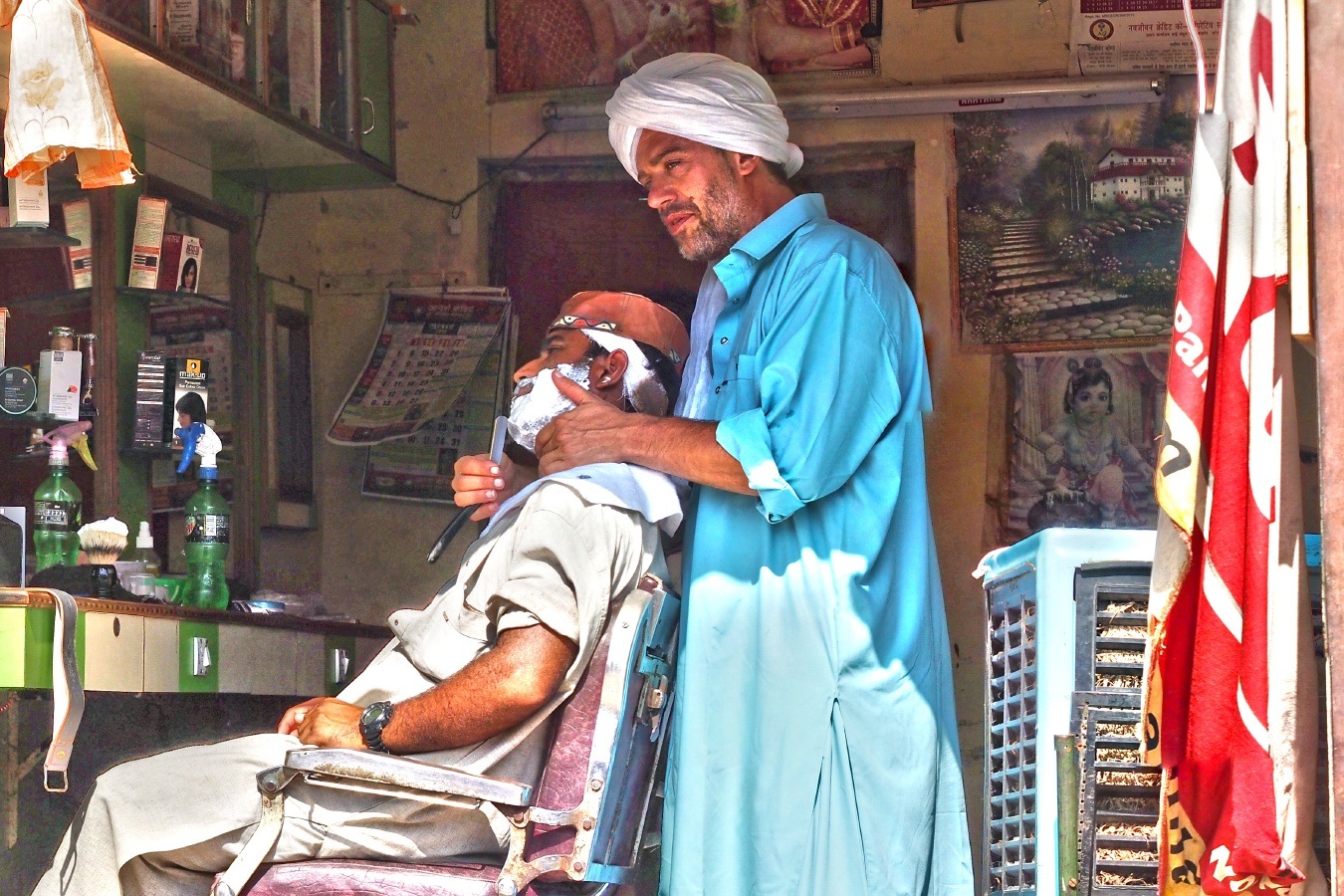
The following picture is another example of Hannes Seebacher’s gifted talent. The thick fog is covering the hill’s tips and the stone-built temple in Ranakpur adds a strong contrast. In these mystical surroundings, Hanne Seebacher undertook a wet shave on his friend Mathar, making the procedure an extra special experience.
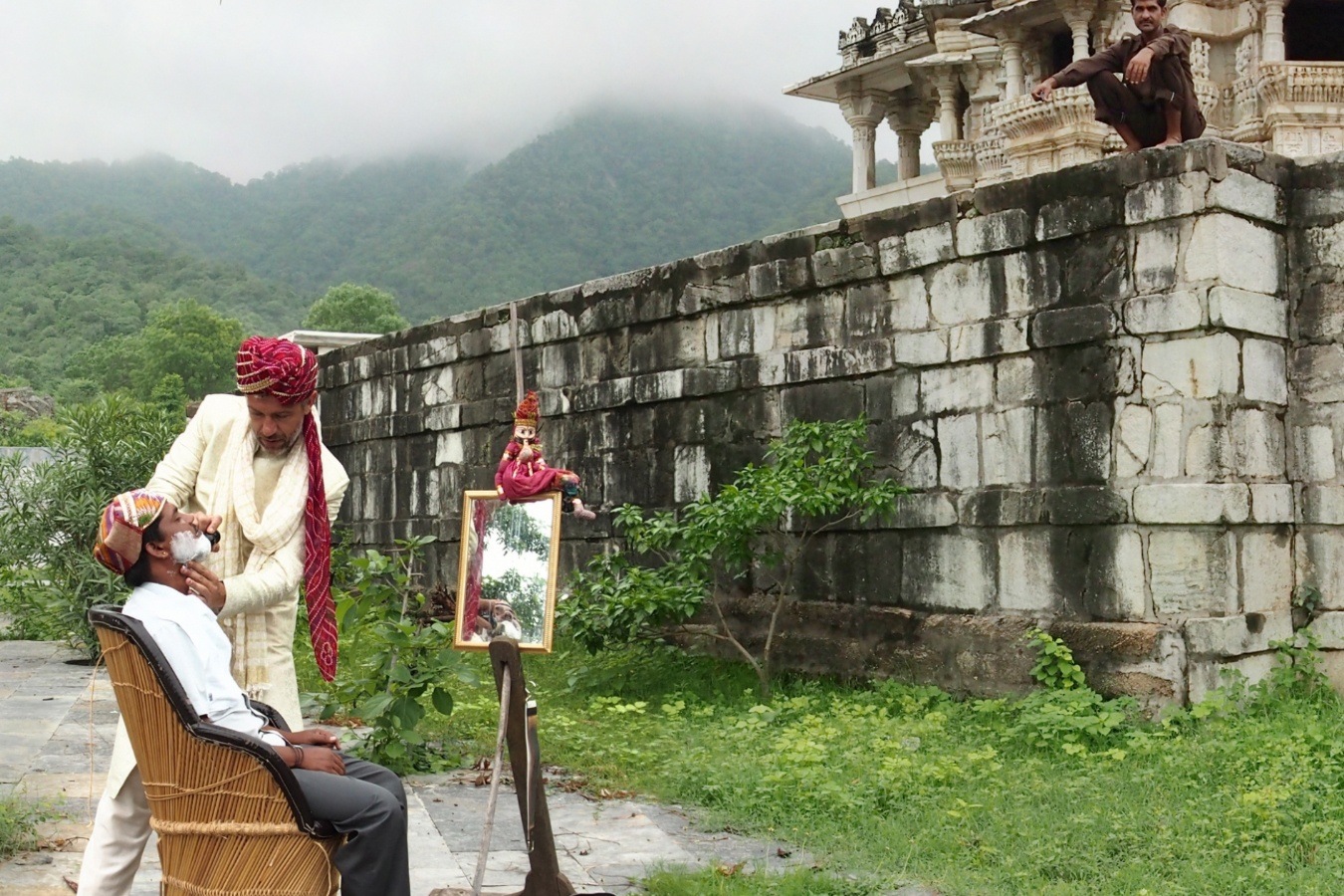
India is always worth a travel. You feel like diving into a completely different world, having once travelled to India, you will never experience life the same as before. As an artist and photographer, the country made a lasting impression on him, opening new perspectives and possibilities and thereby enabling him to the broaden his horizons.
His travel to India was only the beginning of the whole journey. Another destination on his list was Iceland. Hannes Seebacher was able to capture the momentum and beauty of the island in his pictures. ESBjERG’s mission is redefine and to add dimension to the art of shaving. Rather than being part of monotonous routine, shaving should bring joy and should keep us with our modern time.
Hannes Seebacher, who was born in 1969 in Kufstein, is a well-known Austrian multidisciplinary artist. He works with various materials and media, making every work of art special. A reoccurring material, which can be found in many of his works is the element water. In 2009, Hannes Seebacher was rewarded with the Neptun Water Prize for ‘WasserKREATIV’ and honored by the environment minister. In addition, in 2006 he won the water sculpture competition in Schwaz. Due to his international reputation, Hannes Seebacher is well-booked and popular in his birth country and also in foreign countries. Not only the materials for his sculptures change but also his place of residence. Since 2005, Hannes Seebacher moves around Arosa (CH), Innsbruck, Berlin, Cologne and Vienna. At the moment, he is in Jordan to find further inspiration, surely having many more great stories to tell after his stay.
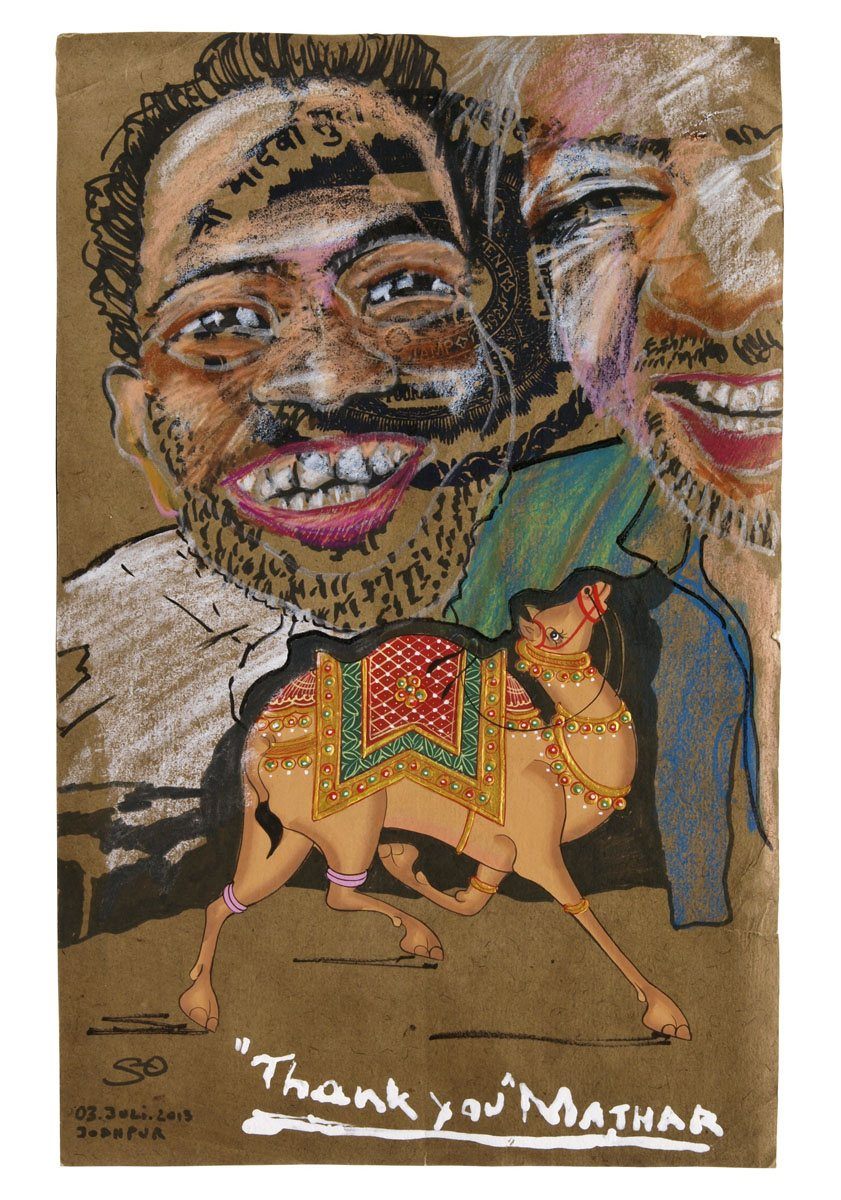
The razor for beginners
We advise newcomers to choose a razor, which’s blades can be exchanged, for example a shavette. It may not be as exact as a classic razor but is a much safer option. However, the handling is the same. As soon as the use of the shavette is mastered, it is time to try yourself with the classic razor.
Caution: When buying this kind of razor, pay attention which material the grip has. Blades made of carbon steel are a better choice than stainless steel. To prevent further rust, do not forget to take care of the blades once in a while.
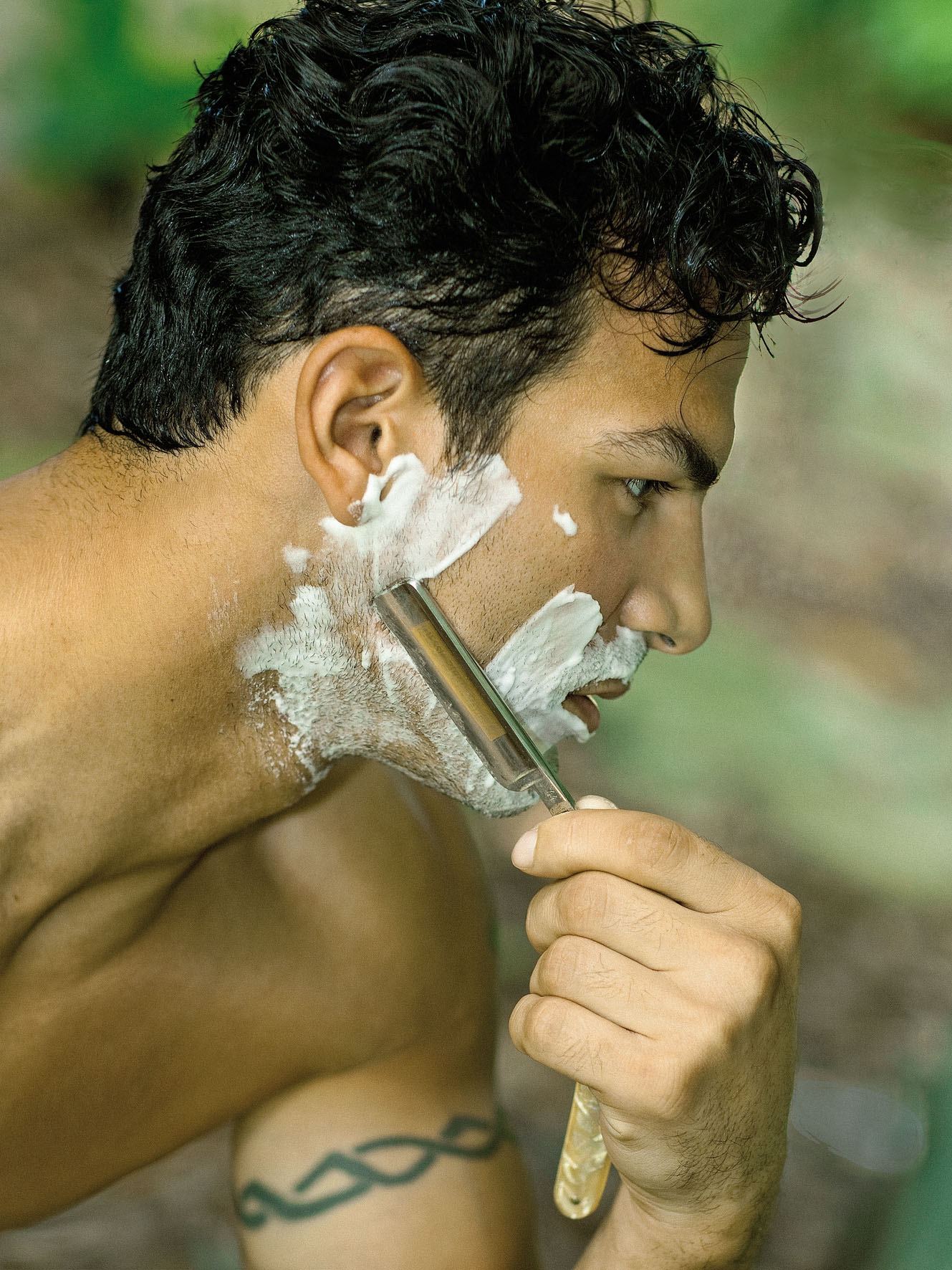
Sharp knifes & gentle care
The sharper the blades the better the razor will glide. Due to this, we recommend a periodic change of the blade. The sharpness of the razor depends on the care that is devoted to it. Maintained blades have a longer life span and are much smoother.
Caution: After shaving, clean the blade with some clear water and gently dry it with a towel. Never rub, by doing so the fine edge is at risk of being destroyed. If the razor will not the used very soon, we advise you to hang it up at a well-aerated spot after being thoroughly greased.
Correct stropping using leather
Stropping is a common term in the technical jargon. Patience is needed to master the art of stropping and also to learn the right movements. It is time for the proper technique! First of all, no stress. Stress only leads to the danger of accidently damaging the strop.
For the procedure, beef leather hanging strops seem to be the best option. The strap should be at least as wide as the length of the edge. The leather side can gladly be covered in some fat especially made for the strops and evenly massaged. The greasing prevents the leather from drying out and keeps it smooth. While stropping, make sure the leather is straight and free from wrinkles. The sleek leather surface should be on top. The razor blade always has to be flat on the belt. Position the edge in a 90 degrees angle on the surface to the body. Hold the razor with your write hand and the handle with your other hand. The edge is always stropped in the direction in which the back of the razor is showing after each strop. Pay attention that the razor is always held flatly. Now carefully stroke the blade over the leather until you hit the other side. Simply turn the blade and repeat.
Caution: When turning, make sure that the edge is not turned over the blade but rather 180 degrees over the back, still being in contact with the leather.
Also important: If the edge might lose its sharpness over time, seek help from a specialist.
Preparation of the brush & shaving soap
The peeling normally starts with the removal of dandruff. This results in making the blade glide better. Brush and Blade should both be placed in some warm water, causing the metal to stretch-out and sharpen-up. We recommend taking a hot shower before shaving, in order to soften the beard hair. Now gradually whisk the foam in a circular movement using the brush. Apply to the beard in the direction of the growth. The foam should soften the beard for about two minutes. In this time, the beard can soften while hydrating, making it easier to cut.
Caution: If you have dry or sensitive skin, apply a preshave creme or Skin Food- product in advance.
All in all, badgehair works best due to its high quality natural hair. It is excellent at soaking up water and thereby gives the basis for a rich foam. Should you seek for an animal-friendly option, there are also various synthetic brushes.
Here you will find an overview of all our brushes.
Size and Material of the grip are only a matter of taste, not having any influence on the consistency of the foam. Following sizes are the most common: S(19mm), M(21mm), L(23mm) and XL(25mm). The grips come in various materials, including: Wood, horn, porcelain, metal and artificial resin.
A high quality shaving soap can be recognized by its high amount of fat and glycerin. Glycerin which origins from plant oil has a good reputation for its moisture. The fat content protects the skin while shaving and should be between 30-50 %.
Caution: Shaving soap should always be alkaline and never have a neutral pH – value or ever sour.
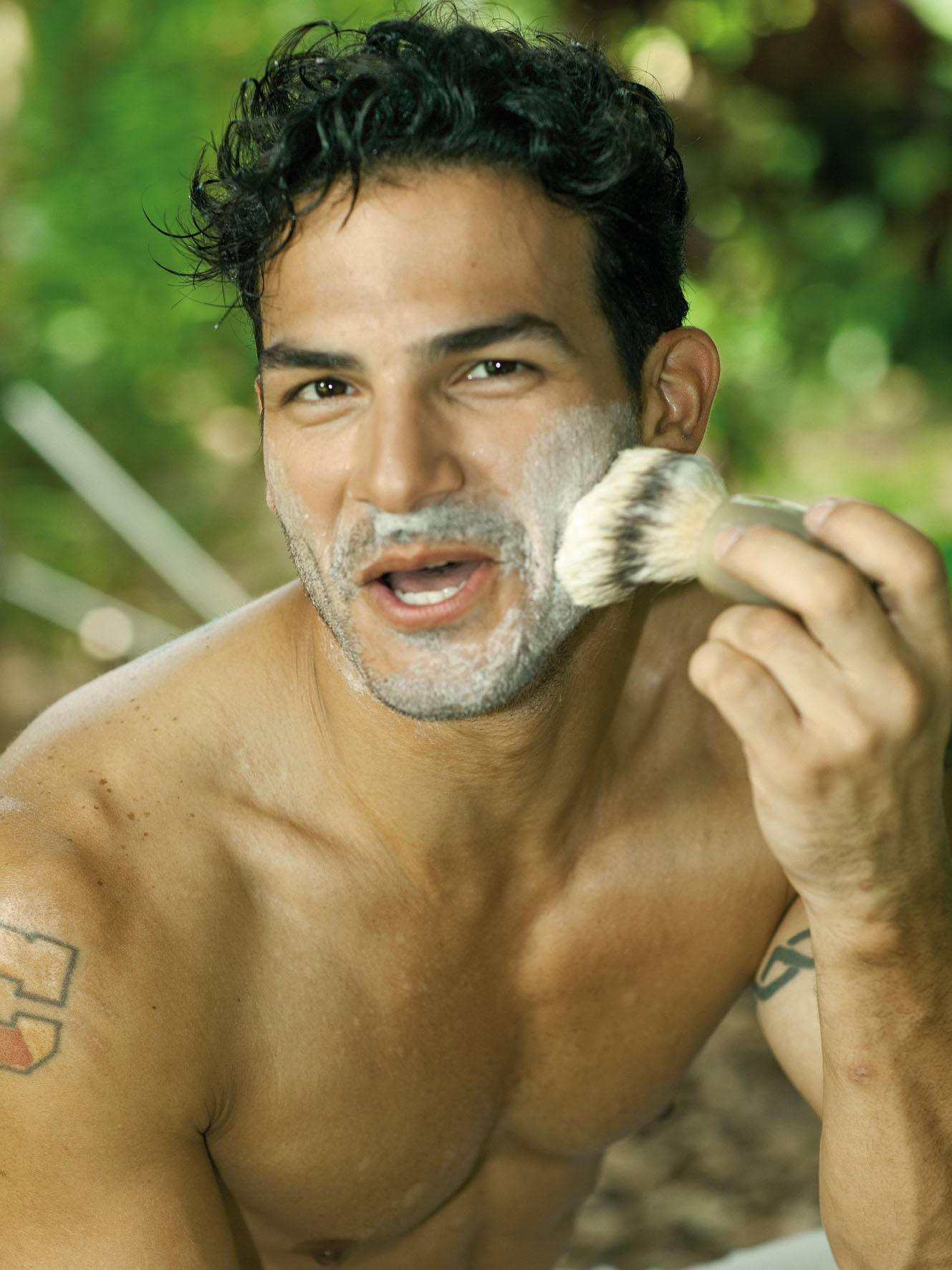
Postprocessing
Please do not use an Eau de Cologne after shaving. Incoming sunrays can leave the skin with uneven spots or even worse, skin irritations. Should your skin feel like it is somewhat burning, you should try using an aftershave lotion. After shave lotions help disinfect the skin and also closes pores. Nowadays, our skin is exposed to a lot of damaging environmental factors, because of this, proper care must be taken into account.
Caution: For dry and sensitive skin we recommend our aftershave-gels, -milks and cremes. They help pamper and clam the skin. In case of extremely dry skin, use an additional moisturizer.
Here you will find an overview of all our aftershave products.
The bath houses of ancient Rome, bursting at the seams with visitors, ushered in a decisive cultural development: Water was no longer just useful, but was also a source of pleasure. This type of public bathing culture, which also went hand in hand with overflowing sensuality, came to an abrupt end with the fall of the Roman empire and the rise of a new code of morals. Based on the Roman bath houses, the Muslims built their own bathing facilities – with the difference being that the splendid hammams were places of leisure and silent rejuvenation. The act of physical cleansing, accompanied by music and meditation, simultaneously celebrated physical seclusion and spiritual contemplation. One stayed here for hours – in some cases, days. Even today, hammams are still an important part of the societal structure of Islamic countries, and Europe has now also discovered these exotic bathing oases for itself.
Formation of the spas
The rapidly increasing flow of visitors to springs said to have healing powers advanced the creation of the first spas in Europe. However, guests could not expect a great number of amenities. Apart from the springs, only spartan accommodations and, in many cases, mediocre food were available. This, however, did not detract visitors. A large number hoped for miracle cures, but reality did have its good sides as well: Numerous springs eased skin diseases and people saw the therapeutic effects on both the body and the soul as something akin to a miracle.
“Water is H2O: Two parts hydrogen, one part oxygen. But there is also a third thing that makes it water. And nobody knows what that may be.” D.H.Lawrence
The age of Reformation replaced alchemy and magic with medicine and ushered in a profound change in values: hygiene for health. Doctors recommended drinking enormous quantities of high mineral content water, which was supposed to cure every single disease. Due to the fact that certain springs were said to hold a higher potential for healing than others, the client structure also underwent a change. The aristocracy and wealthy individuals represented a patient segment that wanted to maintain its luxurious lifestyle while staying at the spa. People demanded exquisite lodgings and elegant facilities – and the cornerstone for the creation of the grandiose spas was laid. The old Roman bath houses were revitalized and Europe caught spa fever. People bathed together, experienced invigoration and rejuvenation, revitalized the soul and strengthened the mind. Last but not least, the baths served as a place to take time off from the Victorian moral code, which was ever-present in daily life. As a result, people enjoyed unchecked eroticism and unburdened freedom in the circle of like-minded spa visitors. Beethoven and Goethe preferred the Karlsbad spa, Napoleon idled in Vichy and Turgenev relaxed at Baden-Baden.
New water trend – new myths
Due to the world wars of the 20th century, the bath houses lost their importance. It was not until the fitness boom of the 1980s that water returned to the public focus in the field where society has always had a major demand and will probably always have one: physical and mental health. Therefore, new myths have also entered into the world of water. Borne by the hope that we could wrest the last secrets from the omnipresent water. One of these new myths – which has not yet been confirmed, but has also not been disproved – is “vitalized water.” This term originates from the observations of the Tyrolean forester and independent natural scientist Viktor Schauberger, who, in the 1920s, came to the conclusion that unknown powers are at work in nature. These release energy in concentric whirls. Based on this observation, he developed the hyperbolic “Schauberger funnel” to improve the quality of drinking water. Instead of storing it in straight pipes, it would be returned to its original spiral curve state, thus energizing and improving the quality of the water. Another similar example is “Grander water,” which is produced using a water vitalization process that represents a healthy medium for useful micro-organisms. Although it has not been scientifically proven, the company’s now global clientele absolutely believes in the effectiveness of Grander water. The Japanese author Masaru Emoto has also entered the fray of the new water myths. His topic of choice is crystal photography, in which he attempts to find a connection between the shape of the crystals and the quality and condition of water. Emoto claims that water can be “animated” and improved by emotion – for example by treating it with music.
“When the well is dry, we understand the value of water.” Benjamin Franklin
One can choose to believe in these myths surrounding water and its properties or not. Nevertheless, animating water is a lovely idea. Especially because there is at least some truth to it. Animating water can also be understood as breathing new life into man. And this feat is one that water has accomplished time and time again over the course of history. Today we call it wellness. More than ever before, the balance between the mind and the body has gained importance in our rapidly moving age. And once again, water, as the universal element, is at the center. As an effective aid for beauty and health. As a comforting way to slow things down. As a way to reduce life to the things that matter – be it a contemplative soak in the tub at home, which helps the mind recover from the overwhelming amount of stimuli we are exposed to every day. A short trip with friends to a health resort where one not only takes care of oneself during the bathing ritual, but also cultivates social contacts. Or just a simple glass of fresh water, which has always revitalized us and lets us remember that not only is every drop precious, but also a part of ourselves.

